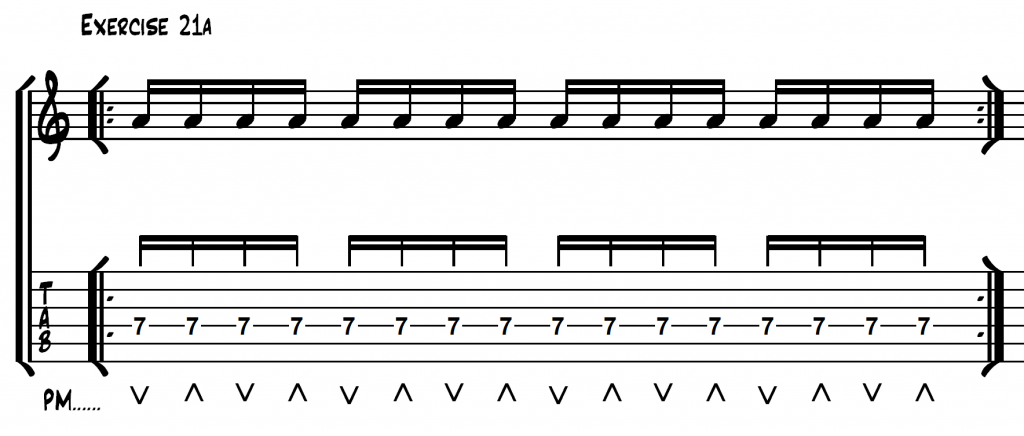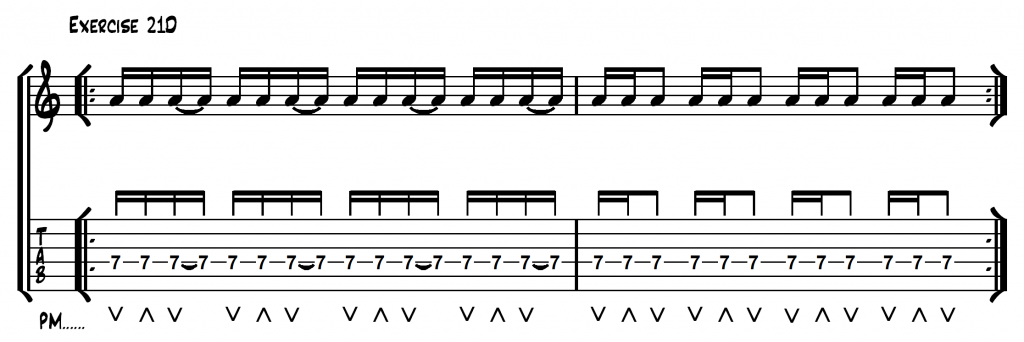How to Pick 16th Note Rhythms on Guitar
It is essential for all guitarists to be able to accurately pick 16th note rhythms on guitar. By correctly using our pick we can keep excellent control of what we play and when we play it.
The rhythms in this lesson are essential vocabulary for all guitarists. They form the foundation of thousands of rock, pop and funk riffs, and you should be able to execute them perfectly. They really are essential to your technical development. To learn them, study the following examples. In particular, pay careful attention to the picking pattern.
Listen to the audio examples first:

Obviously, this exercise is a simple case of continued alternate picking throughout; however, I draw your attention to it because it is the basis of the following three examples. We will study what happens when we start to vary this rhythm by missing out some of the notes in each 4-note grouping. Study the following:

In exercise 21b, I have tied together the first 2 notes of each 4 in the first bar. In musical terms this means play the 1st note, and hold it for the value of the 2nd.
In other words, pick the 1st note, hold it for the value of the 2nd and your next pick is the 3rd note.
Tying two, 1/16th notes together in this way gives them the same value as a single 1/8th note.
The 2nd bar in the example shows exactly the same rhythm as the 1st, it’s just written in an easier manner to understand.
Now look at the picking directions along the bottom line. As we have removed the 2nd note from the rhythm, we simply remove the 2nd pick, (the up-pick) from the sequence.
Executing the rhythm in this way gives us an extremely consistent method by which to control our timing. Listen to the accompanying audio example to hear this played.
How to Pick 16th Note rhythms on guitar
In a similar way to the previous example, exercise 21c ties together the 2nd and 3rd notes of each 4-note grouping:

Again, the rhythm in the 2nd bar is identical to the one in the first.
Play this by missing out the 3rd pick, (a down) in each group of 4. Play along with the audio example until you have this internalised.
The last combination is shown in exercise 21d:

This time we’re missing out the last pick of each 4. You picking will be ‘Down up down. Down up down’. Etc.
Now, let’s try combining some of the rhythmic possibilities for each beat.
Again, listen to the audio examples so you can hear how to pick 16th note rhythms on guitar.

I’ve included a 1/4 note on beat 4 to give your picking hand a little bit of a rest between each repeat.
To play the previous rhythm, break each beat down into its individual picking pattern:
1) Down. Down Up
2) Down up. Down
3) Down up. Up
4) Down
Say the above rhythms out-loud and in time with a click at 60bpm to internalise each one before you play it. Also, listen to the audio example to help you.
Try the same rhythm with some muted power chords: Instant Metallica.

Here are some more rhythms to get you going, they all work great as funk, rock or fusion rhythm patterns.



As in exercise 22b, try making riffs or solos out of each line. You could, for example, try running scales, intervals, triads or arpeggios with the rhythms in this section. Here’s an example using the rhythm from exercise 22a with a simple ascending A major scale:

This is a great exercise because if you economy pick the line, you break the ‘down up down up’ rule of this chapter when you change string. By economy picking the exercise, you work on your internal clock and don’t rely on picking to execute the line properly.
This lesson is an extract from my book: Complete Technique for Modern Guitar.
